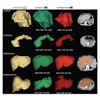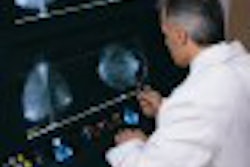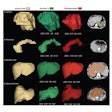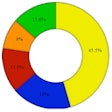Radiologists are better able to spot hazy opacities on chest x-rays using a computer-aided-diagnosis system that generates temporal subtraction images from current and previous radiographs, a Japanese study found.
Researchers from Osaka University Graduate School of Medicine published their findings in the American Journal of Roentgenology. They found that identifying hazy opacities on serial chest x-rays can be critical in catching certain lung cancers early on -- the only time when they are surgically resectable and therefore curable (AJR, August 2002, Vol.179:2, pp. 467-471).
The patients' x-ray exams exhibited opacities due to a variety of abnormal conditions, including several different forms of pneumonia and pneumonitis. The researchers looked at how temporal subtraction affected the performance of radiologists looking at radiographs from 60 patients, half of whom had newly evident opacities confirmed by CT.
A temporal subtraction image is obtained by comparing a previous patient image to a current one digitally, in a process that enhances and highlights any changes on chest images that occurred during the acquisition interval. The researchers created temporal subtraction images using an interactive image-warping technique. The CAD system used was a Truedia/XR developed by Mitsubishi Space Software, based in Amagasaki, Japan.
Ten radiologists examined images from 30 healthy patients, and from 30 patients with new multifocal hazy pulmonary opacities (ground-glass shadow) confirmed by CT. They looked at current and previous radiographs with and without temporal subtraction images, in two interpretation sessions that were spaced apart by at least four weeks to reduce learning effects.
To create the additional temporal subtraction images, chest radiographs from both film-screen and digital radiography sources were digitized with a spatial resolution of 0.171 mm per pixel and 4096 gray levels using a Canon Film Scanner 300. That process did require some time: about 30 seconds to digitize an image, 8 seconds to send it to the server, and 5 seconds to make a subtraction image.
The process of temporal subtraction consisted of the following:
- Normalization of density and contrast images
- Correction for lateral inclination by image rotation
- Rib cage edge detection based on image profile analysis
- Smoothing of low-resolution images using a gaussian filter (matrix size, 128 x 128)
- Lung segmentation using the rib cage edge
- Initial image matching, nonlinear image warping
- Image subtraction
The images were then viewed on a diagnostic workstation with three monitors displaying the previous, current, and, when appropriate, temporal subtraction images.
Some of the radiology residents identified false-positive findings that looked like hazy opacities on the temporal subtraction images, which were caused by misregistration or differences in exposure between the previous and current radiographs, the authors wrote.
Despite these issues, the residents in the study provided more accurate interpretations when aided by temporal subtraction. On a curve ranging from 0.5 to 1.0 (the best possible match with the CT gold standard), the four residents improved their performance to 0.855 with temporal subtraction from 0.765 without.
The six senior board-certified chest radiologists scored a 0.947 with temporal subtraction, vs. 0.916 achieved without temporal subtraction. Paradoxically, the improvement by the senior radiologists reached statistical significance while the greater absolute improvement by the residents did not.
"These results suggest that the temporal subtraction technique was particularly helpful in detecting the abnormality of hazy pulmonary opacities when the observers had greater experience," the authors wrote. They also noted that the smaller number of residents involved, and the widely varying interpretation skills among them, could explain the anomaly.
In addition, the high scores achieved by senior radiologists, even without temporal subtraction, "suggested either that the observers were highly skilled or that the opacities were not as subtle as one might suppose," the authors noted. "It would have been more accurate to use general radiologists with varied skills as observers for better analysis of this technique."
Nonetheless, they concluded, "the temporal subtraction technique clearly improved the diagnostic accuracy for the detection of hazy pulmonary opacities on chest radiographs." Other researchers have also found value in temporal subtraction of chest radiographs, as noted in a presentation at the 2001 RSNA meeting.
By Tracie L. ThompsonAuntMinnie.com contributing writer
October 11, 2002
Related Reading
CT, x-ray to face off in lung cancer screening megatrial, September 19, 2002
Flat-panel DR shrinks chest x-ray dose, May 7, 2002
Bigger not necessarily better for digital chest x-ray matrix, January 15, 2002
Temporal subtraction CR adds up in pulmonary imaging, December 28, 2001
Tips and techniques for decubitus and oblique chest x-rays, December 21, 2001
Copyright © 2002 AuntMinnie.com
















